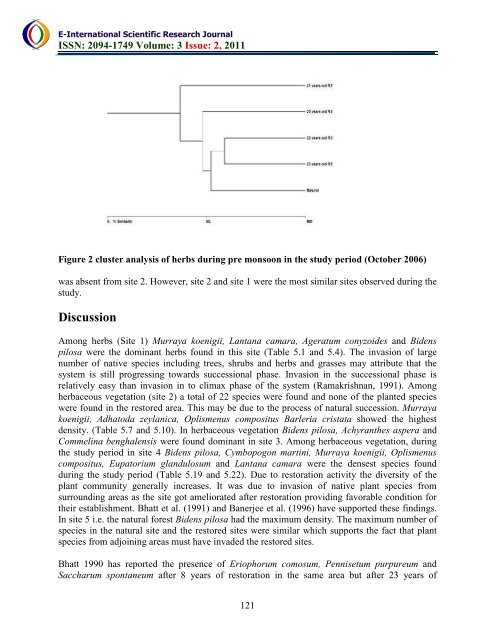download the full article here - E-International Scientific Research ...
download the full article here - E-International Scientific Research ...
download the full article here - E-International Scientific Research ...
You also want an ePaper? Increase the reach of your titles
YUMPU automatically turns print PDFs into web optimized ePapers that Google loves.
E-<strong>International</strong> <strong>Scientific</strong> <strong>Research</strong> Journal<br />
ISSN: 2094-1749 Volume: 3 Issue: 2, 2011<br />
Figure 2 cluster analysis of herbs during pre monsoon in <strong>the</strong> study period (October 2006)<br />
was absent from site 2. However, site 2 and site 1 were <strong>the</strong> most similar sites observed during <strong>the</strong><br />
study.<br />
Discussion<br />
Among herbs (Site 1) Murraya koenigii, Lantana camara, Ageratum conyzoides and Bidens<br />
pilosa were <strong>the</strong> dominant herbs found in this site (Table 5.1 and 5.4). The invasion of large<br />
number of native species including trees, shrubs and herbs and grasses may attribute that <strong>the</strong><br />
system is still progressing towards successional phase. Invasion in <strong>the</strong> successional phase is<br />
relatively easy than invasion in to climax phase of <strong>the</strong> system (Ramakrishnan, 1991). Among<br />
herbaceous vegetation (site 2) a total of 22 species were found and none of <strong>the</strong> planted species<br />
were found in <strong>the</strong> restored area. This may be due to <strong>the</strong> process of natural succession. Murraya<br />
koenigii, Adhatoda zeylanica, Oplismenus compositus Barleria cristata showed <strong>the</strong> highest<br />
density. (Table 5.7 and 5.10). In herbaceous vegetation Bidens pilosa, Achyran<strong>the</strong>s aspera and<br />
Commelina benghalensis were found dominant in site 3. Among herbaceous vegetation, during<br />
<strong>the</strong> study period in site 4 Bidens pilosa, Cymbopogon martini, Murraya koenigii, Oplismenus<br />
compositus, Eupatorium glandulosum and Lantana camara were <strong>the</strong> densest species found<br />
during <strong>the</strong> study period (Table 5.19 and 5.22). Due to restoration activity <strong>the</strong> diversity of <strong>the</strong><br />
plant community generally increases. It was due to invasion of native plant species from<br />
surrounding areas as <strong>the</strong> site got ameliorated after restoration providing favorable condition for<br />
<strong>the</strong>ir establishment. Bhatt et al. (1991) and Banerjee et al. (1996) have supported <strong>the</strong>se findings.<br />
In site 5 i.e. <strong>the</strong> natural forest Bidens pilosa had <strong>the</strong> maximum density. The maximum number of<br />
species in <strong>the</strong> natural site and <strong>the</strong> restored sites were similar which supports <strong>the</strong> fact that plant<br />
species from adjoining areas must have invaded <strong>the</strong> restored sites.<br />
Bhatt 1990 has reported <strong>the</strong> presence of Eriophorum comosum, Pennisetum purpureum and<br />
Saccharum spontaneum after 8 years of restoration in <strong>the</strong> same area but after 23 years of<br />
121

















